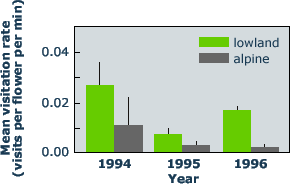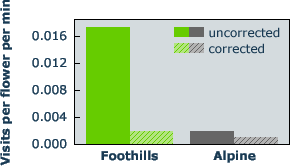 |
|
|
|
|
|
|
Alpine flowers wait for their pollinators Although pollination seems not to be limited by the availability of potential pollinators, cold weather and strong winds at high altitudes may affect pollinator visiting rates. Pollinators do not fly when wind speed is below 4 ms-1. Visiting rates of flowers in the lowland are usually between one and several visits per flower and hour. At high altitudes visiting rates are much lower. In the Central Andes mean visiting rates in Ranunculus acris (Ranunculaceae) were only 0.25 at middle and 0.19 at high elevations. Similar low visiting rates were observed for Eritrichium nanum at 3000 m in the Swiss Alps. Alpine plants may, however, compensate for such low visiting rates by:
Pollination in alpine and lowland plants is thus more comparable than would be expected from the lower insect diversity and limited pollinator activity alone. Increased floral longevity is probably an important adaptation to low pollinator visiting rates in alpine habitats. There are many other ways by which seed set may be limited in the cold
|
Longer stigma receptivity can largely compensate for low pollinator visiting
1 - Pollination rates of Campanula rotundifolia (Campanulaceae) in lowland and alpine communities (Bingham 1998).
2 - Visitatons to alpine and lowland populations of C. rotundifolia: uncorrected and corrected for the shorter duration of stigmatic receptivity at low elevation (Bingham 1998). |
29 August 2011 |
||
| |
||

